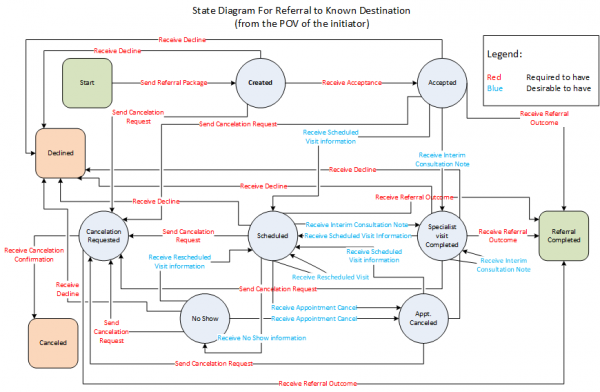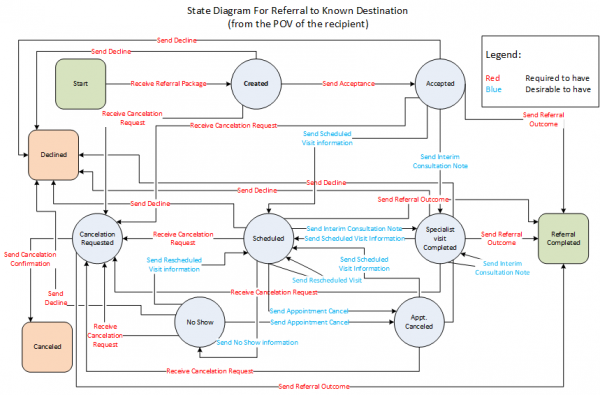Difference between revisions of "201809 VA Closed-Loop Referrals"
| Line 27: | Line 27: | ||
* Veterans Health Administration (VHA) | * Veterans Health Administration (VHA) | ||
| + | * Allscripts | ||
| + | * InterSystems | ||
| + | * Perspecta | ||
* ''Your organization here!'' | * ''Your organization here!'' | ||
| Line 48: | Line 51: | ||
==Scenarios== | ==Scenarios== | ||
| − | The following two scenarios are included from the ONC 36X Project as an illustration of referral state transitions. The first diagram shows state transitions from the point of view (POV) of the referral initiator, and the second diagram from the point of view of the referral recipient. | + | The following two scenarios are included from the [https://oncprojectracking.healthit.gov/wiki/display/TechLab360X/Referral+Workflow ONC 36X Project Referral Workflow] as an illustration of referral state transitions. The first diagram shows state transitions from the point of view (POV) of the referral initiator, and the second diagram from the point of view of the referral recipient. |
[[File:360X_State_Diagram_SPOV_20160824.png|600px|thumb|left|Referral initiator]] | [[File:360X_State_Diagram_SPOV_20160824.png|600px|thumb|left|Referral initiator]] | ||
[[File:360X_State_Diagram_RPOV_20160824.png|600px|thumb|left|Referral recipient]] | [[File:360X_State_Diagram_RPOV_20160824.png|600px|thumb|left|Referral recipient]] | ||
Revision as of 17:10, 6 August 2018
Return to September 2018 FHIR Connectathon 19 home page
VA Closed-Loop Referrals
Submitting WG/Project/Implementer Group
- U.S. Veterans Health Administration
- Healthcare Services Platform Consortium (HSPC)
Justification
The U.S. Veterans Health Administration (VHA) seeks to achieve seamless care for Veterans across the continuum of care that increasingly includes healthcare services outside of VHA at community care providers. Estimates indicate that 30% of Veteran healthcare occurs outside of the VHA network and 60% of Veterans receive part of their care from community providers. Improving standards and interoperability for closed-loop referrals between VHA and community providers is an essential capability required to achieve seamless care. Although this requirement is certainly not limited to VHA and its community providers, the use cases and clinical data examples featured in this connectathon track will emphasize healthcare for Veterans.
The U.S. Office of the National Coordinator for Health Information Technology (ONC) organized the 360Exchange (360X) Project to accelerate interoperable health care data exchange in heterogeneous EHRT environments. In particular, the 360X Project seeks to enable providers to exchange the following types of clinical information from within their EHRT workflow, regardless of the EHRT used:
- Referral requests containing relevant patient clinical information
- Result of referral containing relevant patient clinical information
Whereas the 360X Project emphasized C-CDA content and Direct transport infrastructure, this connectathon track focuses on fulfilling these requirements using FHIR resources, REST architecture for transport, and OAuth2 for security.
Proposed Track Leads
??
Expected participants
The following organizations have indicated an interest in participating in this track:
- Veterans Health Administration (VHA)
- Allscripts
- InterSystems
- Perspecta
- Your organization here!
Roles
FHIR Data Server
A FHIR server (version 3.0) should support the following resources for closed-loop referral workflow, in addition to core clinical data (Patient, Observation, etc):
Optional Resources:
A FHIR server is available for testing with sample data that represent one or more care plan scenarios.
- HSPC sandbox server (FHIR 3.0.1) at Endpoint TBD
FHIR Knowledge Asset Server
A FHIR server (version 3.0) should support the following resources for knowledge-based care management:
- PlanDefinition, ActivityDefinition, Library
Scenarios
The following two scenarios are included from the ONC 36X Project Referral Workflow as an illustration of referral state transitions. The first diagram shows state transitions from the point of view (POV) of the referral initiator, and the second diagram from the point of view of the referral recipient.

